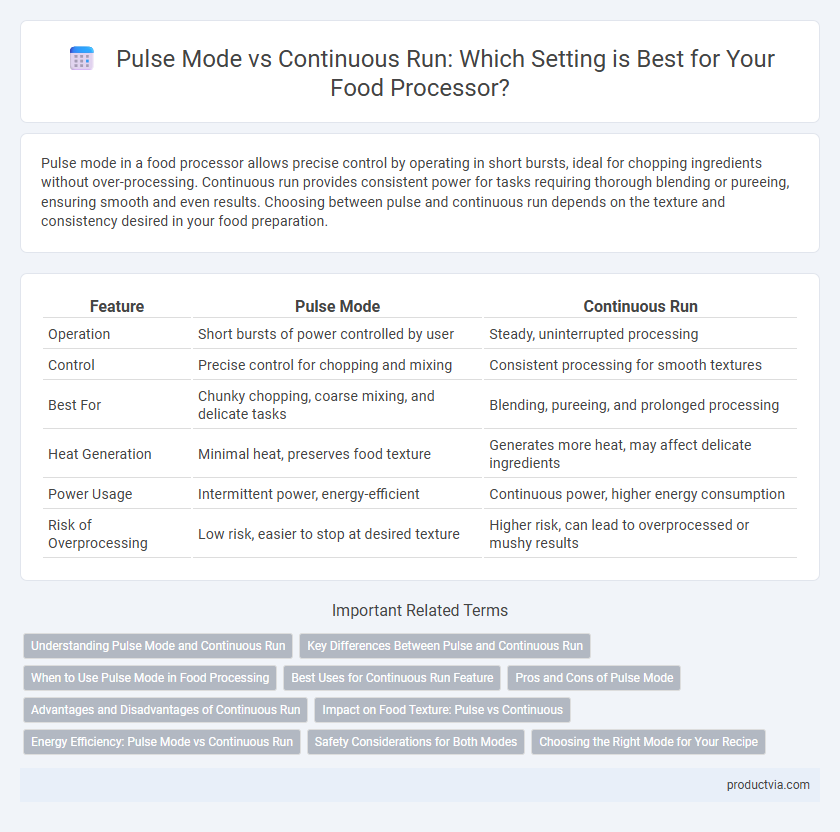Pulse mode in a food processor allows precise control by operating in short bursts, ideal for chopping ingredients without over-processing. Continuous run provides consistent power for tasks requiring thorough blending or pureeing, ensuring smooth and even results. Choosing between pulse and continuous run depends on the texture and consistency desired in your food preparation.
Table of Comparison
| Feature | Pulse Mode | Continuous Run |
|---|---|---|
| Operation | Short bursts of power controlled by user | Steady, uninterrupted processing |
| Control | Precise control for chopping and mixing | Consistent processing for smooth textures |
| Best For | Chunky chopping, coarse mixing, and delicate tasks | Blending, pureeing, and prolonged processing |
| Heat Generation | Minimal heat, preserves food texture | Generates more heat, may affect delicate ingredients |
| Power Usage | Intermittent power, energy-efficient | Continuous power, higher energy consumption |
| Risk of Overprocessing | Low risk, easier to stop at desired texture | Higher risk, can lead to overprocessed or mushy results |
Understanding Pulse Mode and Continuous Run
Pulse mode in a food processor offers controlled bursts of power, allowing precise chopping and preventing over-processing, ideal for tasks like chopping nuts or creating coarse textures. Continuous run delivers consistent, uninterrupted power for thorough blending, mixing, or pureeing, suitable for smooth sauces and dough preparation. Choosing between pulse mode and continuous run depends on the desired texture and processing control, enhancing versatility in food preparation.
Key Differences Between Pulse and Continuous Run
Pulse mode in a food processor allows short bursts of power to finely control chopping or mixing, preventing over-processing of ingredients. Continuous run operates at a steady speed for a longer duration, ideal for blending or pureeing tasks that require consistent texture. Pulse mode offers precision, while continuous run provides efficiency for thorough processing.
When to Use Pulse Mode in Food Processing
Pulse mode in a food processor is ideal for tasks requiring precise control over texture, such as chopping nuts, onions, or herbs without turning them into a puree. It allows for short bursts of power, preventing over-processing and maintaining ingredient integrity. Use pulse mode when you need to achieve a coarse or chunky consistency quickly.
Best Uses for Continuous Run Feature
Continuous run mode in a food processor is ideal for tasks requiring consistent, uninterrupted blending such as making purees, doughs, or large quantities of sauces. This feature ensures uniform texture by maintaining steady blade movement, enhancing efficiency and reducing processing time. Continuous running is also beneficial when handling tougher ingredients like nuts or fibrous vegetables, providing thorough and even chopping.
Pros and Cons of Pulse Mode
Pulse mode in food processors allows for short bursts of power, providing greater control over chopping and blending, which helps prevent over-processing of ingredients. This mode is ideal for tasks requiring precision, such as chopping nuts or creating chunky salsa, but can be less efficient for longer mixing or pureeing tasks compared to continuous run. Pulse mode may increase preparation time and requires more user attention, but it enhances texture control and reduces the risk of overheating the motor.
Advantages and Disadvantages of Continuous Run
Continuous run mode in a food processor allows for uninterrupted blending, making it ideal for processing large quantities of ingredients quickly and evenly. It offers consistent power and speed, ensuring efficient chopping, pureeing, or mixing without manual intervention, but prolonged use may cause motor overheating or loss of control over texture. Unlike pulse mode, continuous run lacks precise control, which can result in over-processed food or uneven consistency for delicate recipes.
Impact on Food Texture: Pulse vs Continuous
Pulse mode in a food processor delivers short, controlled bursts of power that help maintain texture by preventing over-processing, ideal for chopping vegetables or mixing dough without turning ingredients into mush. Continuous run provides consistent, long-duration blending that results in smoother, more uniform textures, suitable for purees and emulsions like sauces and smoothies. Choosing pulse preserves chunkiness and structure, while continuous run achieves finer, more homogenous blends.
Energy Efficiency: Pulse Mode vs Continuous Run
Pulse mode in food processors enhances energy efficiency by delivering short bursts of power, minimizing overall energy consumption compared to continuous run. Continuous run operation uses a steady, prolonged power draw, which can lead to higher electricity use and increased motor wear. Utilizing pulse mode reduces energy waste while maintaining precise control over food texture and processing time.
Safety Considerations for Both Modes
Pulse mode in food processors enhances safety by allowing precise control over chopping or mixing, minimizing the risk of over-processing or motor overheating. Continuous run mode requires careful monitoring to prevent overheating and potential electrical hazards, especially during extended use. Ensuring the food processor has built-in safety features like automatic shutoff and secure locking mechanisms is critical for safe operation in both modes.
Choosing the Right Mode for Your Recipe
Pulse mode in a food processor offers precise control for chopping, mixing, or blending ingredients in short bursts, ideal for recipes requiring coarse textures or minimal processing. Continuous run mode provides consistent power for thorough blending, pureeing, or kneading, perfect for smooth sauces, doughs, or large quantities. Selecting the right mode enhances recipe outcomes by matching the processing style to ingredient texture and desired consistency.
Pulse mode vs continuous run for food processor Infographic

 productvia.com
productvia.com